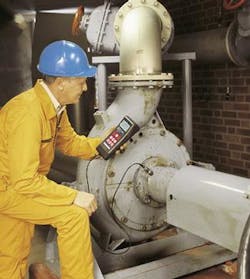Condition Monitoring - Comprehensive maintenance program extends uptime, life-span of rotating machinery
Complete solutions for the condition monitoring of rotating machinery are available from SPM Instrument, which numbers several leading oil companies among its customers.
The company has developed a range of instruments and systems, including handheld devices for in-situ measurement, online systems, and analytical software. It can provide complete packages embracing engineering, installation, training, and after-service. Its equipment and services also provide an efficient platform for implementing a condition-based maintenance (CBM) strategy, according to Jan Hoflin, area export manager.
Use of the company's condition monitoring technology can bring significant economic benefits, he adds. Seeing maintenance only as a cost is to overlook the important contribution it can make to improving production from a life-cycle perspective. To put concrete figures to such a claim, SPM has produced software known as EcoMaster for calculating the benefits of CBM.
By inputting the failure frequency of a specific machine and the track record of consequential damage arising from failure, EcoMaster calculates the direct cost in terms of labor and parts required to effect the repair, and the indirect costs arising from the consequences of the failure. The sum of these costs could be avoided by adopting a planned maintenance strategy based on condition monitoring, Hoflin says.
Shock pulse method
SPM's history in condition monitoring goes back to the 1960s, when it patented the shock pulse method for monitoring the state of rolling element bearings. As such a bearing rotates, it generates shock waves in response to the constant loading and unloading to which it is subjected. A well lubricated, undamaged bearing gives off a low shock level, whereas a deteriorating or misaligned bearing gives off a high shock level. Both the level and the pattern of shock can be monitored and interpreted to provide information on the state of the bearing.
The shock pulse measurement is made through a metal stud installed on the bearing housing. SPM passed a notable milestone in 1980 with the installation of its millionth such measuring point.
The company then turned its attention to the measurement of vibration severity, which is the ISO's recommended method for general machine condition monitoring. A different approach is required here, Hoflin says. Whereas shock pulse measurement measures the amplitude of a transient wave, the vibration severity reading represents an average of all vibration components within a wide and a comparatively low frequency range.
null
null
SPM followed up by developing ways of analyzing the vibration data to detect trends and predict upcoming parts failure. In 1997 it launched the Evaluated Vibration Analysis Method (Evam), which generates three sets of condition data – condition parameters, vibration spectra, and machine-specific condition codes and values.
Readings are made using the same measuring point. Some simple input data is required to allow the data to be interpreted – in the case of bearings the shaft size and turning speed (rpm), or in the case of gear-boxes, the number of teeth.
Green/yellow/red
Shock pulse and vibration measurements have been combined in a single instrument. Since 2002 this has been the versatile Leonova tool, a hand-held machine with a touch-screen capable of measuring shock pulses, vibration, speed, temperature, and analog signals in voltage and current. It incorporates both Evam and SPM Spectrum, a program for verifying the source of high shock pulse readings. SPM recently added a laser-based shaft alignment facility known as LineLazer to Leonova's capabilities.
The company's comprehensive condition monitoring and predictive maintenance program is known as CondmasterPro. This stores and evaluates data from all SPM instruments, provides continuous condition monitoring and administers measuring, lubrication, inspection, and other maintenance routines.
The company attaches great importance to making its equipment user-friendly, Hoflin says. For example, the hand-held instruments used by the "front-line staff" – those who perform the measurements at the machine – should be simple to operate and give a clear indication of where any necessary trouble-shooting should be directed. They should make it possible for the user to cover as many machines as possible in as short a time as possible.
In this regard, there is no point in wasting time making unnecessary computations on machinery that is functioning well. The SPM equipment therefore incorporates a color-coded system for indicating whether action is required. Green means no action is required, yellow that action will be required in the future, and red that action is required straight away.
SPM's oil and gas reference list includes installations for PGS, Pemex, Kerr-McGee, Gazprom, Lukoil, and Yukos.
For more information contact Jan Hoflin, SPM Instrument. Tel +46 152 22500, fax +46 152 15075, [email protected], www.spminstrument.com.


